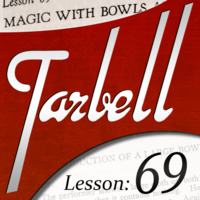Tarbell 69: Magic with Bowls and Liquids (Instant Download)
Unique miracles, fascinating methods, waiting to be discovered by you.
| List price: | |
| Price: | $9.96 |
| You save: | $10.04 (50%) |
Production of a Large Bowl of Water: Learn how to make the special costume for the production of a large cooler full of ice and beer.
Production of Stack of Four Bowls of Water: Using the same costume, you'll learn how to produce tall stacks of many bowls filled with colorful water.
Chinese Production of the Four Bowls: Using the same gimmick as the previous production, you'll learn how to produce tall stacks of many bowls filled without a special costume.
Production of a Child: Learn how to produce a small child, instantly on stage, with only a cloth and a chair. This brand new method requires none of the previous cumbersome contraptions and costumes, and it's adaptable to just about any stage.
Modern Production of a Bowl of Water on a Table: Produce a large fisbowl from thin air. You will learn all the details on how to construct a special table for this killer production.
The Vanishing Bowl of Water: You'll learn all the work on the once-popular vanishing bowl of water, with an all new handling.
Chinese Production of Doves: A fun and interesting way to produce a small live animal.
ASK HERE
Featured Magic Tricks

 Complex magic made less intimidating
Report this review
Complex magic made less intimidating
Report this review
This video is light on the methods used in the book. If you want a history lesson, this isn't the best choice. It is aimed at people who want to perform these tricks.
Here are my notes on each trick.
Production of a Large Bowl of Water: a famous trick that originally required a specific type of performance that few would be interested in doing today. It is updated to be usable for more performers, but it still has practicality issues.
Production of Four Bowls of Water: a lovely effect, but a lot of work for a short moment. It can be used to produce any tall object.
Production of a Child: a surprising effect that's easy to achieve. Uterus not required.
Modern Production of a Bowl: a method from the book that's still in common use, with some extra touches to make it even more deceptive.
Vanishing Bowl: a trick with a great moment of shock. I want to do it.
Production of Doves: I don't like the custom prop that's similar to what the book uses -- I'd buy a magic store version instead. Has a good idea for a routine.

 Handy person's delight
Report this review
Handy person's delight
Report this review
'How to ' MAKE, in the sense of how to fabricate, construct, use measurements, glues, epoxy, thread, wire, duct tape, magnets, plexiglass/plastic, fabrics and plywood are the major and common ingredients of Harlan's mechanics.
Harlan pays attention to each and all of these, including 'sourcing' the appropriate physical materials - which is particularly useful for wanna-be magicians learning to construct magic effects. The range of sources is constantly extending as new technologies become available at affordable prices and ease.
Sources now include not merely the local hard-ware stores and paint shops but also, those specialising in art, office supplies, all craft supplies, 1 dollar stores, model (railways/trains, aircraft, boats,buildings) supply shops, garden furniture and irrigation supply, computer and radio supply stores, fabrics and cottons, dance supply, steampunk supply and party supply stores.
What Harlan - via Mr Tarbell - does, is clearly show/demonstrate ways to combine materials from places such as these, to set-up and several perform magic tricks using bowls and liquids.

 Easy to make and do classics
Report this review
Easy to make and do classics
Report this review
Dan does his usual great job of updating the effects, as well as giving construction details and materials to use.
A really great job to add these to your show. Classics for a reason, and made more deceptive by Dan.

 Tool Time is Here
Report this review
Tool Time is Here
Report this review

 LOVE IT!
Report this review
LOVE IT!
Report this review

 Handy person's delight
Report this review
Handy person's delight
Report this review
'How to ' MAKE, in the sense of how to fabricate, construct, use measurements, glues, epoxy, thread, wire, duct tape, magnets, plexiglass/plastic, fabrics and plywood are the major and common ingredients of Harlan's mechanics.
Harlan pays attention to each and all of these, including 'sourcing' the appropriate physical materials - which is particularly useful for wanna-be magicians learning to construct magic effects. The range of sources is constantly extending as new technologies become available at affordable prices and ease.
Sources now include not merely the local hard-ware stores and paint shops but also, those specialising in art, office supplies, all craft supplies, 1 dollar stores, model (railways/trains, aircraft, boats,buildings) supply shops, garden furniture and irrigation supply, computer and radio supply stores, fabrics and cottons, dance supply, steampunk supply and party supply stores.
What Harlan - via Mr Tarbell - does, is clearly show/demonstrate ways to combine materials from places such as these, to set-up and several perform magic tricks using bowls and liquids.

 Thank you Dan Harlan
Report this review
Thank you Dan Harlan
Report this review

 Tarbell 69
Report this review
Tarbell 69
Report this review






























